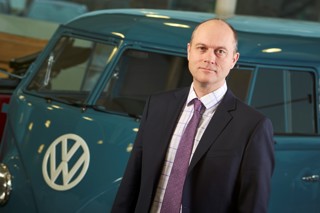Change is afoot at Volkswagen Commercial Vehicles (VWCV) as the brand ushers in a range of new models, its first electric vehicle (EV) and new ways of working as a result of its recently refreshed management team.
“Working with you” is the mantra that employees have adopted and, this year, the company seeks to speed up and smooth out its offering of bespoke fleet vehicles as part of that promise.
“We’ve been working a lot with the factory on customer orientation and customer solutions,” says Claire English (pictured), VWCV head of fleet.
“We’ve been looking at aftersales but from a sales perspective. Where we’ve got a customer with a specific requirement how can we speed up the process by getting into the heart of factory?
“Working with you, that is our methodology. If we can work even closer with the factory to get the solutions for our customers, that can be very positive.”
A close relationship with the brand’s plants means VWCV UK staff have the flexibility to offer fleet customers a turn-key solution to their needs.
That can incorporate anything from bespoke paint colours and modifications to factory specifications to full fitouts and conversions.
The result is a quick turnaround and a factory-approved vehicle with one invoice and no leg work for a fleet operator to get their ideal vehicles.
To enhance the service, the brand is introducing a new digital solution to use during its sales presentations with customers. Using 3D modelling, it allows a vehicle to be built and customised virtually then demonstrated to the customer on a tablet; giving them a 360-degree view of what the finished product will look like.
English joined the CV division of Volkswagen in June, moving across from the passenger car side of the business. Her most recent role was national contract hire and leasing manager, where she is credited for playing a “key role” in the development of the brand’s fleet strategy.
Replacing David Hanna, who is now head of service and parts at VWCV, English is responsible for all fleet sales through the five area sales managers and key and central account managers, rental and leasing managers and the local business development managers within the brand’s 72 Volkswagen Van Centres.
Move to electric
EVs are high on the agenda for many fleet operators and VWCV is planning to launch its first model, based on Transporter, this year.
“Our customers are desperate to find out when they can have electric. It’s a hot topic that we are being asked about all the time,” says English.
Initially, the company will deploy some left-hand-drive demonstrator vehicles to do trials with customers. Production-ready right-hand-drive models are expected to be ready for delivery before the end of the year.
“Our team members are really excited about getting EVs. They’ve seen car, with the e-Golf, but now we have our own model to talk about,” explains English.
While customer demand is expected to be high, she believes many fleets are not ready for a mass take-up of EVs with most looking to “test the water” with a smaller number.
“Diesel vans still dominate. It will take time to shift,” says English. “If you take Golf, it is not a specific vehicle, it is a Golf that is electric. It’s the same with Transporter. From a driveability perspective it looks like it and feels like it, making the transition easier.”
The e-Transporter, first unveiled at the IAA Commercial Vehicles show in 2018 and then later showcased at the 2019 CV Show, is built by third-party tuning company ABT.
At its unveil, VWCV announced that the twin-battery (77.6kWh) version has a driving range of 250 miles NEDC, while a single-battery (38.8kWh) variant offers 134 miles. The electric motor drives the front wheels in e-Transporter and delivers 112PS and 220Nm of torque.
When the vehicle makes full production, it will be based on the new T6.1 facelift Transporter rather than the old T6 platform on which the vehicles were previously shown.
An electric Caddy, built by ABT, was also pitched for release last year but was subsequently shelved as an all-new model is due for release this year.
Positive performance in 2019
Sales grew by 2% at VWCV in 2019, slightly behind the overall commercial vehicle market (2.4%) but enough to make the UK the brand’s second biggest market. Registrations of 47,998 sees VWCV behind only market leader Ford in the overall sales rankings for the year.
Transporter was the best-selling model, by some margin, shifting almost 24,000 units.
Caddy sales declined by around 700 units to 10,902 in 2019. This was driven by a combination of the model being due for replacement and the company losing a contract with British Gas.
English remains upbeat about the model, despite it being at the end of its life. “Caddy is still really popular and we still get a lot of proposals. The feedback from all the customers is they really like the Caddy. It’s great to have that reputation to carry over to the new model,” she says.
Crafter, the brand’s biggest van, has seen a vast increase in sales since it was replaced two years ago. Almost 10,000 were handed over in 2019, in contrast with around 5,000 units in 2017.
Digital revolution
Expanding on its ‘working with you’ promise, VWCV is introducing a range of new digital and connected solutions to further enhance the customer experience it offers.
The new Transporter is the first vehicle in the brand’s range to come with We Connect Plus, a new connected service that provides a digital link between the fleet operator, driver, vehicle and Volkswagen Van Centre. The brand’s existing telematics service, provided in partnership with the RAC, will continue to be supported although it hopes customers will switch to the new We Connect system when they replace their vehicles.
Using the technology, if the vehicle identifies a fault while being driven, it can notify the van centre and a technician can assess the best course of action – that could be to schedule a visit to the workshop or arrange a mobile repair.
It builds on the firm’s Breakdown Hotline, launched last year, where roadside assistance technicians can feed diagnostic information to the van centre so necessary repairs can be carried out as quickly as possible upon the vehicle’s arrival.
For bigger fleets, the service can be extended to report faults directly to a fleet operator – enabling them to take the best course of action.
The new connected service also enables other features, such as remote access to a vehicle.
English says it can help fleets do away with having multiple keys – an often costly exercise.
“It’s a big cost. If there is new technology that allows someone to get in without the keys. That is a practical application. The technology exists in the car-sharing industry with rental companies. We need to offer the service to make use of it in a practical way.”
It would enable a mobile technician to access and work on the vehicle without the driver being present. It could also be used by businesses to enable seamless loading or unloading or for access to vehicles by multiple drivers.
The initiatives contribute towards the brand’s strategy to boost its retention and aftersales business through improved customer satisfaction.





















Login to comment
Comments
No comments have been made yet.